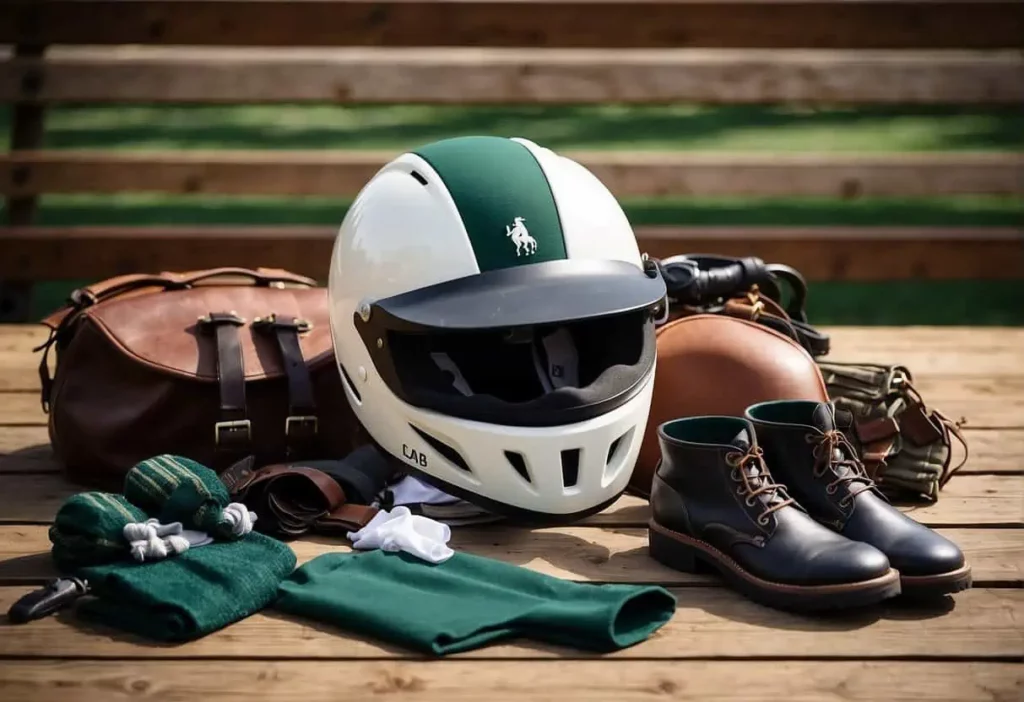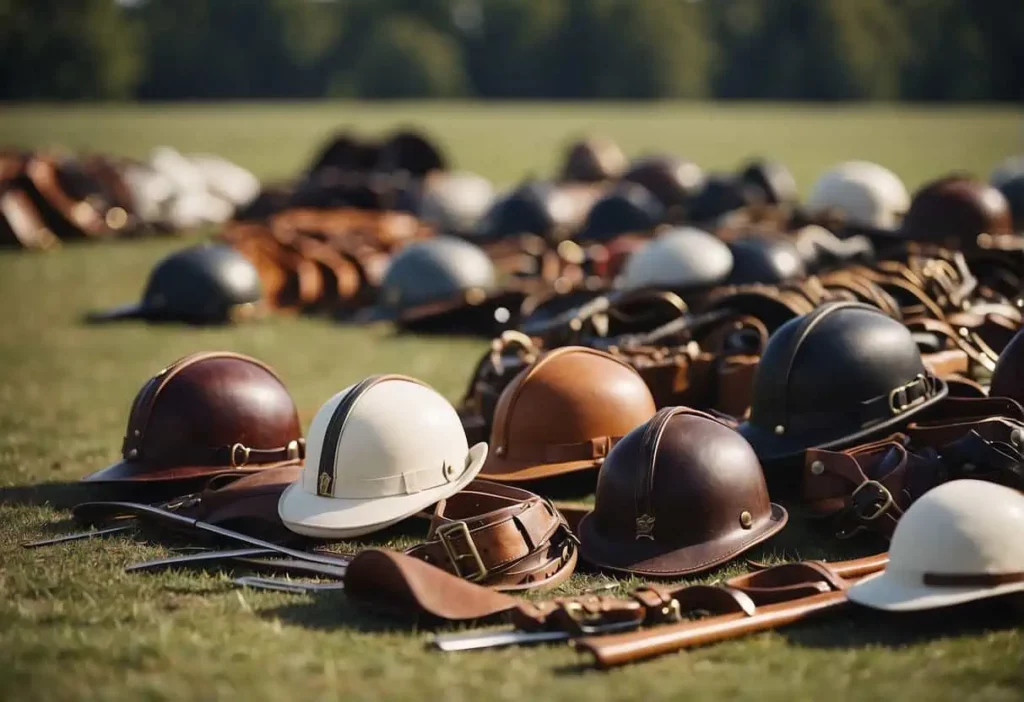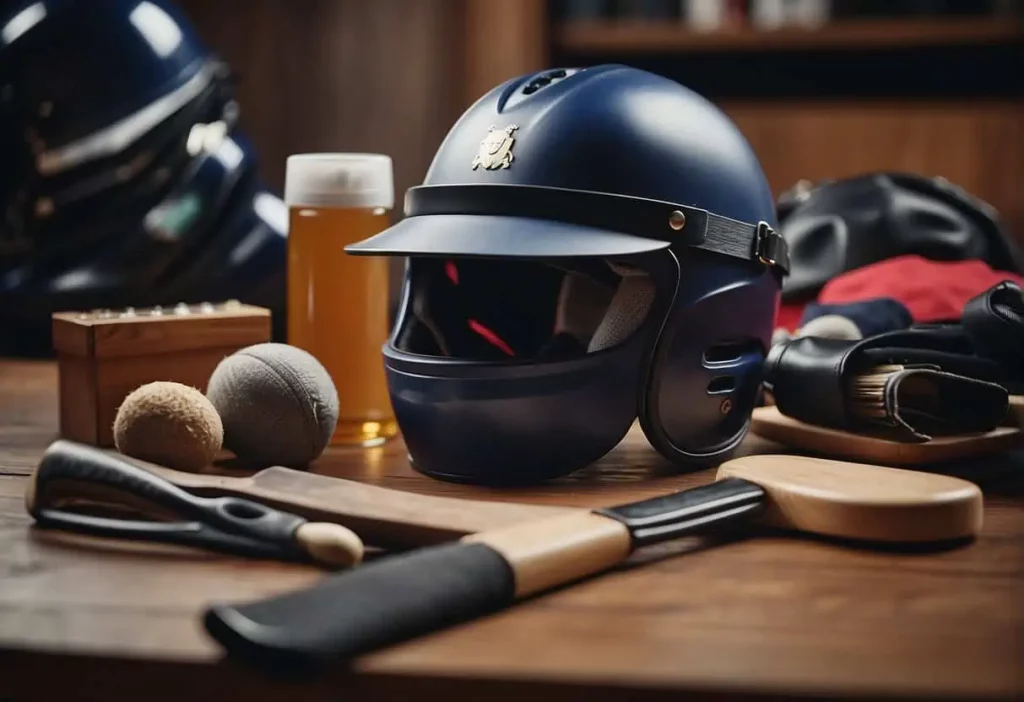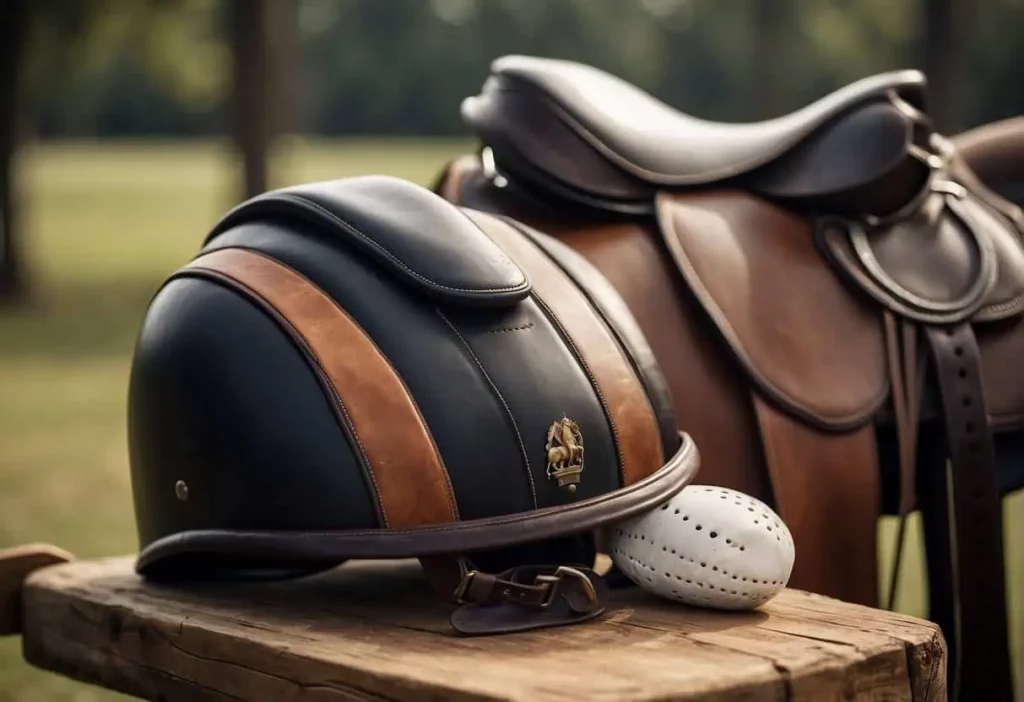Polo, known as the “sport of kings,” requires specialized equipment for both horse and rider. This ensures safety, functionality, and adherence to the traditions of the game. Polo equipment has evolved with the sport, balancing the need for durable materials that can withstand the rigors of gameplay with the requirement for comfort and maneuverability.
Riders, known as polo players, must be equipped with the appropriate gear, such as helmets, boots, and mallets. Meanwhile, their mounts require a different set of equipment, including saddles, bridles, and protective boots.
Proper maintenance and care of polo equipment are vital to both performance and longevity. It is crucial to select high-quality gear that can endure the sport’s pace and physical demands. Team dynamic in polo extends to the uniformity and customization of equipment. This can influence team identity and spirit.
When considering the acquisition of polo gear, potential buyers must not only factor in the initial purchase but also the aftercare. Ongoing maintenance is key to ensuring the equipment’s safety and effectiveness on the field.
Key Takeaways
- Polo requires specific equipment for players and horses, centered on safety and efficiency.
- Quality and maintenance of the equipment significantly impact performance and durability.
- Team cohesion is reflected in the coordinated and customized gear and apparel.
Polo Equipment Essentials
Selecting the right equipment is crucial for both safety and performance in polo. Each piece, from the saddle to the ball, is designed for the demands of the sport. This ensures the comfort of the horse and rider as well as the durability of the gear.
Polo Saddles
Polo saddles are a cornerstone of the player’s gear, designed to be comfortable for both horse and rider without sacrificing quality or durability. A well-fitted polo saddle allows for better control and stability, enhancing a player’s performance.
It is essential to choose a saddle that balances fit with quality materials to withstand the rigors of the game.
Polo Mallets
Polo mallets are crafted to balance weight and durability for optimal performance. A high-quality mallet can significantly impact a player’s swing and accuracy.
Regular maintenance of the mallet, such as checking the cane and replacing the mallet head as needed, is essential to maintaining its performance.
Polo Helmets
Safety is paramount in polo, making a well-constructed polo helmet essential. Helmets must provide a comfortable fit while ensuring safety with features such as reinforced shells and faceguards.
Adequate vents for airflow contribute to the helmet’s comfort, without compromising on quality or protection.
Polo Balls
The polo ball is an integral part of the game, influencing the flow and performance of play.
Quality polo balls are designed to have a consistent weight and size for an accurate flight path. The material used should be able to withstand hard strikes and various playing surfaces, ensuring lasting performance throughout the game.
Rider Gear and Apparel

In the sport of polo, player attire is not only about tradition and appearance but also gear that ensures safety and comfort. Optimal performance hinges on selecting high-quality, durable equipment specifically designed for the rigorous demands of the game.
Polo Boots
Polo boots are crafted for protection and agility. They are typically made of thick, high-quality leather, extending above the knee to protect against mallet swings and ball strikes.
Durability is key, with reinforced heels and toes ensuring that the boots withstand the sport’s intensity. Boots must also be comfortable to permit fluid movements and swift rides.
Polo Whites
Polo whites refer to the classic white trousers that players wear during a match.
Comfort and durability converge in the design of polo whites, as they should allow for a full range of motion while also being able to endure rough play. High-quality fabrics that can resist repeated wear and staining are standard for any seasoned player’s wardrobe.
Polo Gloves
The gloves worn in polo are tailored to provide a strong grip on the mallet, and they are essential for both performance and safety.
Polo gloves are usually made from supple, durable leather or high-tech synthetic materials. These materials allow for a finer feel on the reins while ensuring the player’s hands are protected from blisters and injury.
Knee Pads and Elbow Pads
Critical for player safety, knee pads and elbow pads are designed to be comfortable yet sturdy enough to absorb impacts.
They are often made from heavy-duty materials like leather, reinforced with padding that can cushion falls and prevent scrapes or more severe injuries. These pads should fit snugly while not impeding movement, a balance that is vital for a polo player’s performance and protection.
Horse Tack and Equipment

Every piece of equipment in polo is selected with a focus on quality, fit, safety, and durability.
From bridles that ensure control and communication with the horse to the protective boots and bandages safeguarding the horse’s legs, careful consideration is given to each item to optimize performance and reduce injury risks.
Polo Bridles
Polo bridles are a critical component of tack, contributing significantly to the control and direction of the horse during play.
They must be of high quality to withstand the rigors of the sport and have a snug fit to avoid discomfort or potential injury to the horse. Durability is essential to resist wear from sweat, dirt, and the fast-paced action inherent in polo.
- Quality: Ensures longevity and reliability.
- Fit: A well-fitted bridle contributes to the horse’s comfort and the rider’s control.
- Safety: Prevents accidents caused by equipment failure.
- Durability: Understand the challenging conditions of polo matches.
Horse Boots and Bandages
Protective boots and bandages are mandatory for polo horses to shield their legs from impact and strain.
The safety of the horse is paramount; therefore, boots must be made from materials that can absorb shock and resist tearing.
The fit of the boots must be perfect, too tight and they can impair circulation, too loose and they offer insufficient protection.
- Boots:
- Material: Durable and shock-absorbent like neoprene or leather.
- Fit: Snug without restricting blood flow.
- Bandages:
- Purpose: Support and additional protection.
- Application: Must be wrapped with consistent tension to offer support without constriction.
Accessory Selection and Care

Selecting the right polo gear is imperative for both the safety and comfort of the player, as well as the performance on the field.
High-quality accessories should offer durability while being lightweight, ensuring that they do not impede agility and movement during play. Proper maintenance of these items extends their lifespan and ensures ongoing reliability.
Polo Gear Maintenance
Regular maintenance is crucial for preserving the quality of polo equipment.
They should clean their leather goods, such as saddles and boots, with a damp cloth after each use and condition them monthly to prevent cracking and drying out.
For non-leather gear such as helmets and kneepads, wiping them down with a mild soapy solution and letting them air dry is recommended to maintain their durability.
- Helmets: Inspect padding and outer shell before use. Replace if there are any visible signs of damage.
- Boots: Store with boot trees to maintain shape and absorb moisture.
- Saddles: Check for loose stitching or worn leather. Use saddle soap for cleaning and mink oil for conditioning.
Additional Accessories
Beyond the essential gear, other accessories serve to enhance the game.
Polo whips should be lightweight yet sturdy, offering precision without being cumbersome.
Players should choose fittings and bags that not only carry their gear efficiently but also provide ample protection from the elements.
It is preferable to select bags with ventilated compartments to allow moist equipment to dry and minimize odor.
- Gloves: Ensure they fit well for optimal grip and control.
- Whips: Choose a comfortable grip and flexible shaft for effective communication with the horse.
- Bags: Opt for durable materials with separate compartments for wet and dry items.
Purchasing and Aftercare
When it comes to procuring polo equipment, selecting reputable brands and understanding the nuances of aftercare, including care, storage, and knowledge of warranty and return policies, are fundamental to safeguarding one’s investment in the sport.
Attention to these details not only ensures safety and performance but also enhances the longevity and comfort provided by the gear.
Choosing Quality Brands
Investing in high-quality polo brands like Pologear™ translates into equipment that is both durable and comfortable. Shoppers should look for products that boast superior craftsmanship. These are likely to offer better performance and safety on the field. Durability also plays a critical role, with well-made items resisting wear and tear over numerous matches and practice sessions.
Care and Storage
Proper maintenance of polo gear is essential for prolonging its life and maintaining its integrity for game day.
After each use, polo gear should be cleaned according to the manufacturer’s instructions. Then, store them safely in specially designed bags to prevent damage.
For example, helmets and boots require airing out to prevent moisture build-up that can degrade materials. Meanwhile, mallets should be stored at room temperature to prevent warping.
Warranty and Returns
A comprehensive understanding of warranty policies and return procedures ensures that players can make informed purchasing decisions.
Most reputable vendors will offer a warranty that covers defects in materials and workmanship.
Keep any receipts and proof of purchase, as they are often needed if a claim with UPS or another shipping service is required due to damaged goods upon arrival.
Additionally, understanding return policies is vital. Customers should be aware of the window for eligible returns and whether they can receive a refund or a gift card for the returned items.
Polo Team Essentials
When equipping a polo team, performance and comfort take center stage. The apparel must ensure players can move freely and remain cool under pressure, with team shirts and jerseys being fundamental.
Team Shirts and Jerseys
Materials:
- High-quality fabric: Jerseys should be made from breathable, moisture-wicking materials such as polyester or a polyester blend to keep players dry and comfortable throughout the game.
- Stretch: A small amount of spandex or elastane can provide the necessary give for ease of movement.
Design:
- Colors and Patterns: Bold and distinctive colors help to differentiate team members on the field. Patterns may be used but should not distract from the visibility of player numbers.
- Logos and Branding: The team logo and sponsor names are typically displayed on jerseys. Placement should not impede performance and must adhere to sport regulations.
Construction:
- Durability: Reinforced stitching is important for withstanding the physical nature of the game.
- Fit: Jerseys should be tailored to fit snugly to avoid getting caught during play but not so tight as to restrict motion. Custom fitting is ideal.
Functionality:
- Collars: Traditional polo shirts feature a collar, which can protect players from the sun. The collar should lay flat against the body to reduce any chance of it catching during play.
- Closures: Shirts often have buttons, but they should be secure and not present a risk of coming loose during play.
High-performance polo apparel, specifically team shirts, is tailored to meet the demands of the sport. Teams wear custom-designed shirts that are not only comfortable but also embody the team’s spirit and identity.
Frequently Asked Questions
In this section, readers will find concise answers relating to the essential components and considerations for acquiring polo equipment, providing clarity on some of the most common inquiries.
What are the essential items included in a complete polo equipment set?
A complete polo equipment set typically includes a polo mallet, helmet, boots, kneepads, gloves, and a face guard. Additionally, players need a saddle, bridle, saddle pad, girth, and polo bandages or wraps for their horse.
How do you choose the right polo mallet?
The right polo mallet should match a player’s arm length and physical strength. The length varies typically from 49 to 54 inches.
Additionally, players usually prefer a mallet that feels balanced and offers a sturdy, well-constructed cane and head to ensure precision and durability.
What are the top brands for polo gear and equipment?
Prominent brands known for quality polo gear include La Martina, Casablanca Polo, and RJ Polo. These brands have established reputations for producing reliable, high-quality equipment suited for players of all levels.
Where can you find reliable second-hand polo equipment?
Reliable second-hand polo equipment can be sourced from specialized online forums, local polo clubs, and social media groups dedicated to polo. Websites like Polomart and services at reputable polo clubs often have listings of used equipment.
What should you consider when purchasing polo equipment for horses?
Purchasing polo equipment for horses requires considering the horse’s size and comfort. Equipment should include well-fitting saddles and bridles, comfortable and protective bandages or boots, girths that prevent chafing, and high-quality saddle pads.
How does one ensure the quality of polo gear when buying online?
To ensure the quality of polo gear when purchasing online, one should prioritize reputable retailers or brands. Look for those with transparent customer reviews and comprehensive product descriptions.
It’s also beneficial to check return policies and guarantees on equipment quality.
Last Updated on February 17, 2024 by Nate Dewsbury



